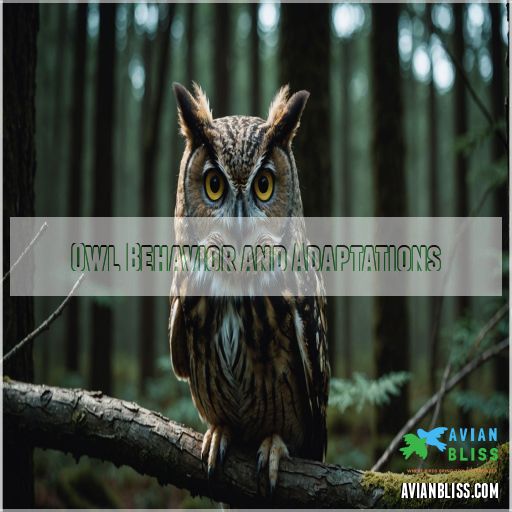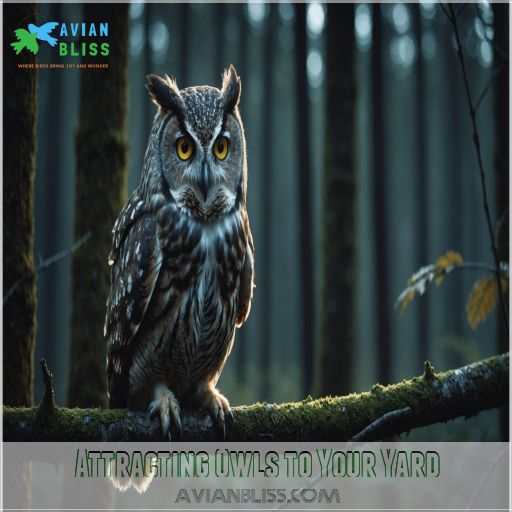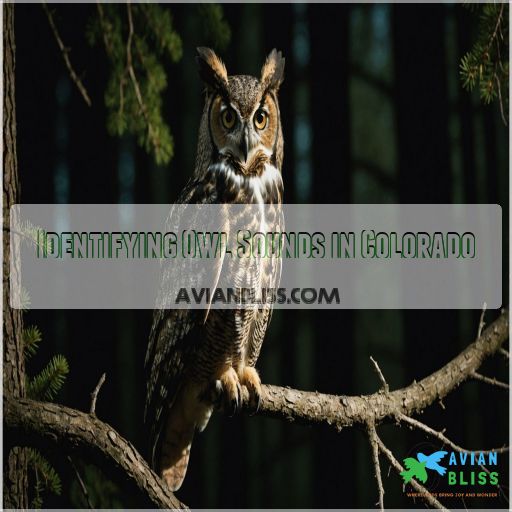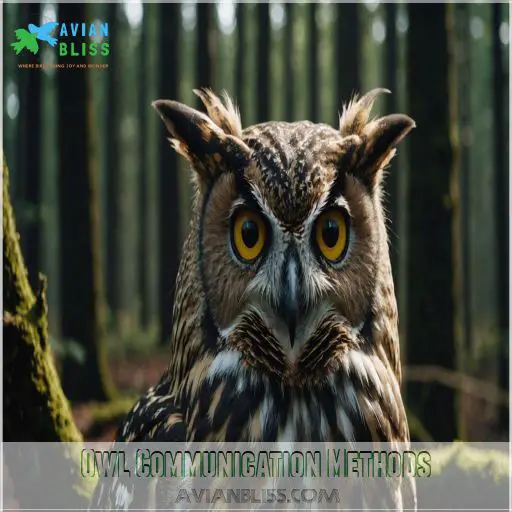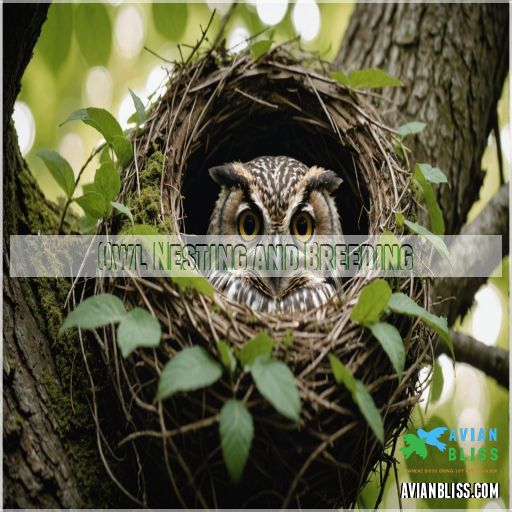This site is supported by our readers. We may earn a commission, at no cost to you, if you purchase through links.
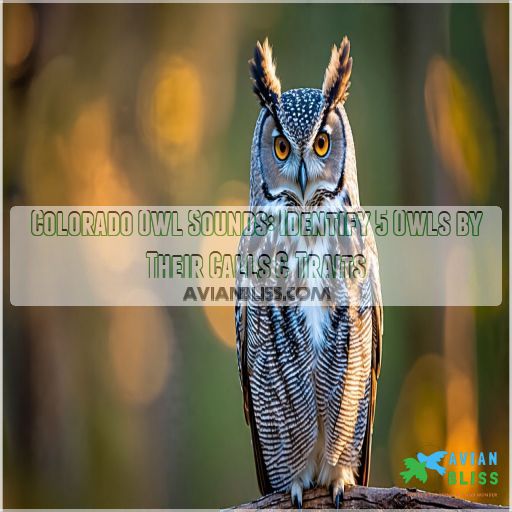 You’ll find a symphony of Colorado owl sounds echoing through the night. The Great Horned Owl’s deep, resonant hoots carry far, while the Burrowing Owl’s softer coos add a gentle undertone.
You’ll find a symphony of Colorado owl sounds echoing through the night. The Great Horned Owl’s deep, resonant hoots carry far, while the Burrowing Owl’s softer coos add a gentle undertone.
These nocturnal melodies aren’t just beautiful; they’re essential for communication, marking territory, and attracting mates. By learning to identify these distinct vocalizations, you’ll gain a deeper understanding of a hidden world of avian conversation.
But there’s more to owls than just their calls… and the unique vocal characteristics of each species, from the Flammulated Owl’s quiet hoots.
Table Of Contents
- Key Takeaways
- Types of Owls in Colorado
- Colorado Owl Sounds
- Owl Migration Patterns
- Owl Behavior and Adaptations
- Attracting Owls to Your Yard
- Identifying Owl Sounds in Colorado
- Owl Communication Methods
- Owl Nesting and Breeding
- Frequently Asked Questions (FAQs)
- How many owl species are there in Colorado?
- How do you find long eared owls in Colorado?
- What does a great horned owl sound like?
- Are there flammulated owls in Colorado?
- What is the most common owl in Colorado?
- What are some of the different noises owls make?
- What owl hoots three times?
- Do owls make other noises besides hoots?
- Can Colorado owls mimic other animal sounds?
- How do urban environments affect owl vocalizations?
- Are there seasonal variations in owl calls?
- Do owls make sounds while flying?
- Can owls learn new sounds or calls?
- Conclusion
Key Takeaways
- Hearing different owl sounds in Colorado is like tuning into nature’s night radio; from the deep hoots of the Great Horned Owl to the gentle coos of the Burrowing Owl, each call tells its own tale.
- You can be a real-life owl whisperer by figuring out who’s who based on their sounds, such as recognizing the Boreal Owl’s melodic hoots or the Short-Eared Owl’s playful whistles.
- Understanding owls isn’t just about listening – it’s about watching, too; owls communicate using body language, from head bobbing to wing claps, adding another layer to their mysterious chatter.
- Owls, like people, adapt to their environments; they even change their calls in noisy urban settings so they can still catch dinner and maybe even find love amidst the hustle and bustle.
Types of Owls in Colorado
In Colorado, you’re likely to encounter a diverse range of owls.
Each with unique characteristics that make them fascinating subjects for bird watchers.
From the majestic Great Horned Owl to the elusive Flammulated Owl.
Understanding these species can enrich your appreciation of nature’s nocturnal wonders.
Description of the Great Horned Owl
Imagine coming across the majestic great horned owl in the Colorado wilderness.
You’ll notice its impressive size—up to 25 inches long—and broad wingspan. This owl thrives across diverse habitats, from forests to backyards.
It features distinct tufts resembling horns. With a diet including rabbits and rodents, it’s a true predator .
Listen for its iconic hooting calls at night.
Identifying the Burrowing Owl
Getting to know the Burrowing Owl is like exploring hidden gems. This small owl hunts during the day, residing in open grasslands and deserts. Listen for its soft coos echoing through its habitat. Conservation efforts are essential as their homes face threats from urban development.
Spot these long-legged owls standing watchful at burrow entrances.
- Habitat: Open grasslands
- Diet: Insects, rodents
- Threats: Habitat loss
- Conservation: Essential for survival
- Nesting: Underground burrows
Characteristics of the Short-Eared Owl
What makes the Short-eared Owl so distinctive? This open-country hunter has a pale, buffy look with a streaked chest and black around its eyes. While its "ear" tufts are often hard to spot, its flight is unmistakable – a buoyant, floppy pattern that resembles a giant moth.
| Trait | Description |
|---|---|
| Habitat | Prairies, marshes, dunes, tundra |
| Diet | Mostly rodents like voles, lemmings, and deer mice |
| Flight | Direct, soaring, and undulating |
Distinguishing Features of the Boreal Owl
As you move from the open fields of the Short-Eared Owl, let’s talk about the Boreal Owl, a secretive night hunter in Colorado.
Recognize them by their distinct features:
- Boreal Owl Size: Small, about 8-10 inches tall.
- Boreal Owl Habitat: Boreal forests.
- Boreal Owl Calls: Melodious yet haunting owl sounds.
Physical Characteristics of the Flammulated Owl
Spotting the elusive flammulated owl might feel like discovering a hidden gem in Colorado’s forests. Its small stature and flame-like markings in gray and reddish-brown hues make it unique. These owls excel at hunting insects in mountainous habitats.
Here’s a closer look:
| Trait | Detail |
|---|---|
| Size | 5.9-6.7 inches (15-17 cm) |
| Wingspan | 15.9-16.1 inches (40-41 cm) |
| Plumage Color | Grayish/reddish variations |
Explore more about their intriguing behaviors next.
Colorado Owl Sounds

If you’ve ever wandered through the Colorado wilderness at night, you might’ve heard the haunting calls of owls echoing through the trees.
Understanding these sounds helps you identify the Great Horned Owl’s deep hoots, the Burrowing Owl’s soft coos, and the varied vocalizations of other species.
Great Horned Owl Vocalizations
With its deep, resonant hoots, the Great Horned Owl uses vocalizations to communicate in the wild.
These owl sounds include complex hooting patterns, signaling territories or attracting mates during the night.
Often heard in duets, their calls are a distinctive part of nighttime vocalizations and offer fascinating insights into owl communication and animal identification through the sounds of nature (Source).
Burrowing Owl Sounds
Listening to Great Horned Owl vocalizations enriches your understanding of nature’s soundscape. But, let’s talk about Burrowing Owl sounds, which are delightful yet distinct.
Their vocalizations combine a series of chatters and coos, especially active at night. These owls are quite expressive.
- Marvel at their nighttime songs.
- Hear their chatters echoing through the dusk.
- Experience their vibrant communication.
- Observe their playful banter.
Short-Eared Owl Calls
You’ll quickly recognize the short-eared owl by its distinct calls, often heard as playful whistles cutting through the night. These nocturnal sounds are particularly noticeable during mating season, similar to the Barred Owl’s "Who cooks for you?" call, which is also a notable example of an owl’s mating ritual.
Additionally, the short-eared owl’s calls can be influenced by its habitat, such as grasslands and prairies, where its raspy bark can be heard.
To identify these fascinating birds, pay attention to the soft hoots and wing claps. Understanding their calls enhances your backyard experience, attracting owls and making identification a breeze.
Boreal Owl Sounds
Intrigued by the mysterious calls of the Short-Eared Owl? Now, let’s explore the enchanting sounds of the Boreal Owl. This nocturnal hunter’s haunting hoots echo through the night, a mesmerizing serenade. Listen for its distinctive "too-too-too" and be enchanted by its nocturnal symphony.
Discover the Boreal Owl’s secrets:
- Solitary males hoot to attract mates
- Females make soft "kek-kek-kek" calls
- Owlets produce high-pitched begging calls
- Boreal Owls hunt small rodents and birds
- These owls thrive in dense, coniferous forests
Flammulated Owl Hooting
Moving from the haunting calls of the boreal owl to the gentle hooting of the flammulated owl, you’ll find this owl’s sounds evoke whispers of a breezy night.
They use variations in hoot for communication, often in mimicry of insects rustling.
| Flammulated Owl | Traits |
|---|---|
| Hooting Season | Late spring to summer |
| Hoot Variations | Soft, like fluttering |
| Common Habitats | Pine forests |
Owl Migration Patterns
As you explore Colorado’s diverse owl species, understanding their migration patterns can offer fascinating insights into their seasonal movements and habitats.
Whether tracking the Great Horned Owl’s territorial stability or the Burrowing Owl’s long travels, each migration pattern highlights unique adaptation strategies in response to environmental changes.
Great Horned Owl Migration
While exploring Colorado’s owl sounds, understanding the Great Horned Owl’s migration patterns paints a vivid picture.
These owls are generally non-migratory but can move southward in winter.
Key factors include:
- Great horned owl migration routes vary slightly in northern areas.
- Breeding grounds are stable throughout the year.
- Migration timing ties to harsh weather.
- Wintering locations depend on prey availability.
Burrowing Owl Migration Patterns
As you’ve seen with the Great Horned Owl’s local wanderings, Burrowing Owl migration patterns involve distinct routes and timing.
These owls migrate south to Mexico and Central America during the winter, facing threats like habitat loss. Factors such as weather and food availability influence their journey.
Here’s a quick look:
| Factor | Impact | Details |
|---|---|---|
| Timing | Winter migration | Southward journey |
| Routes | Limited knowledge | Typically southbound |
| Threats | Habitat loss | Urban expansion |
| Wintering Grounds | Mexico, Central America | Mild climates |
| Influences | Weather, food resources | Migration drives |
Short-Eared Owl Migratory Behavior
Consider how adaptable Short-eared Owls are with their facultative migratory behavior. These birds follow flexible migration routes influenced by weather and prey availability, typically heading to wintering grounds as conditions demand.
During breeding season, they prefer open habitats like prairies and marshes.
However, threats like habitat loss can disrupt their migration, posing significant challenges to their survival.
Boreal Owl Wintering Grounds
Short-eared owls venture on long migrations, but Boreal Owls find their winter grounds by responding to food availability.
During challenging winters, they irrupt south from their boreal habitats in search of prey like mice and shrews, particularly in areas like northeastern Minnesota.
Observing these elusive birds showcases nature’s resourcefulness, revealing the delicate balance in owl migration routes.
Flammulated Owl Summer Habitat
Discover the summer habitat of the elusive Flammulated Owl.
These tiny forest dwellers thrive in mature Ponderosa pine and Douglas fir forests with a thick understory.
They’ll nest in old woodpecker cavities, 15-40 feet up.
Look for them at dusk, hunting insects like moths and beetles. Their haunting calls may surprise you at night, especially in areas with a thick understory.
Owl Behavior and Adaptations
When you’re observing owls in Colorado, you’ll notice their unique behaviors and adaptations that help them survive in diverse habitats.
From the silent flight of the Great Horned Owl to the social dynamics of the Flammulated Owl, each species showcases fascinating traits that enhance their hunting and survival strategies, including their hunting and survival strategies.
Hunting Techniques of the Great Horned Owl
With silent flight and powerful talons, you’ll find the Great Horned Owl to be a masterful nocturnal hunter. These birds use keen eyesight and hearing to locate prey, swooping down from high perches.
Their hunting techniques are diverse and effective:
| Technique | Description | Prey Types |
|---|---|---|
| Perch and Pounce | Wait on high, then swoop | Rodents, rabbits |
| Ground Stalking | Walk or wade to catch prey | Frogs, fish |
| Ambush Tactics | Use cover for surprise attacks | Birds, larger mammals |
You’d be amazed at their adaptability and precision in securing a meal.
Burrowing Owl Nesting Behavior
Unlike their tree-dwelling cousins, burrowing owls make their homes underground.
You’ll find these quirky birds nesting in abandoned burrows of prairie dogs or other small mammals. They’re not afraid to get their talons dirty, sometimes digging their own burrows if necessary.
These savvy owls line their nests with grass, roots, and even dung to mask their scent from predators. It’s a clever strategy for survival in the open prairies where they can be found using abandoned burrows.
Short-Eared Owl Roosting Habits
Short-eared owls break the mold in terms of roosting habits.
You’ll find these quirky birds:
- Snoozing on the ground in tall grass during breeding season
- Roosting in trees during snowy winters, sometimes with other owl species
- Favoring open areas like grasslands, marshes, and tundra
- Gathering in social roosts of up to 100 birds outside breeding season
They’re often active during daylight, especially at dusk, making them easier to spot than their nocturnal cousins.
Boreal Owl Feeding Patterns
During nightfall, you’ll find boreal owls setting out on their nightly hunt.
These nocturnal predators primarily feast on voles, mice, and shrews, with the occasional small bird or insect rounding out their diet.
They’ve got a clever hunting technique: perching in the forest, they use their asymmetrical skull and large ears to pinpoint prey sounds with incredible precision.
Talk about a midnight snack with style!
Flammulated Owl Social Structure
Flammulated owls might be small, but they’ve got big personalities in terms of their social lives.
You’ll find these pint-sized predators pairing up during breeding season, often returning to familiar territories. Their courtship is quite the spectacle – males dive past females in a daring display of aerial prowess.
Like many owl species, flammulated owls are known to form long-lasting monogamous bonds, with some pairs staying together for multiple breeding seasons after engaging in elaborate courtship rituals.
Once paired, these owls become close-knit, preening each other’s feathers and cooing softly. It’s like they’re whispering sweet nothings in owl language!
Attracting Owls to Your Yard
You can transform your backyard into an owl haven with a few simple steps.
By creating the right habitat and minimizing disturbances, you’ll increase your chances of hosting these fascinating nocturnal visitors.
Installing Owl Nesting Boxes
Now that you’ve learned about owl behavior, let’s attract these feathered friends to your yard. Installing nesting boxes can be a hoot! Here’s your guide to successful owl box installations:
- Choose the right height: 8-10 feet is perfect for easy monitoring
- Face the entrance east or south for sunbathing owls
- Use metal poles to deter unwanted guests
- Add 1-2 inches of hardwood mulch for cozy nesting
Remember, you’re not just building a box; you’re creating a home sweet home for nature’s nighttime guardians.
Creating a Habitat for Owls
Ready to transform your yard into an owl’s paradise?
Start with owl-friendly landscaping by planting native evergreens for daytime roosting. Create a brush pile far from your home to attract small mammals, the owl’s favorite snack (Source).
For nest box placement, aim 10-12 feet high on trees along your property’s edge.
Remember, a wild yard is a happy hunting ground for owls, so let those grass blades grow a bit longer. This helps to create a happy hunting ground for owls and provides them with a favorite snack.
Setting Up Bird Feeders
You’ve set the stage for owls, but don’t expect them to flock to traditional bird feeders.
Instead, these nocturnal hunters are drawn to the buffet of rodents attracted by fallen seeds.
Place feeders strategically to create a natural hunting ground.
Choose a mix of seeds that’ll entice small critters, and let some scatter on the ground.
It’s like setting up a five-star restaurant for owls, where the menu is always fresh and moving!
Limiting Outdoor Activity
While creating an owl-friendly yard, it’s essential to limit outdoor activity, especially at night. This simple act can have a profound impact on wildlife conservation efforts. To minimize noise pollution and promote nighttime quiet, it’s crucial to understand that owls rely on their acute hearing to hunt and communicate, often using vocalizations as a hunting strategy.
By respecting their nocturnal nature, we also safeguard their ability to use their territorial calls to establish ownership and warning signals to other animals.
- Restrict evening events to end by 6 p.m.
- Use repellent and stay indoors from dusk to dawn
- Encourage community participation in protecting vulnerable species
By respecting owls’ nocturnal nature, you’re not just attracting them but also safeguarding their habitat. Remember, a little consideration goes a long way in fostering harmonious coexistence with these majestic creatures.
Providing Perches for Owls
Owls need a bird’s-eye view to hunt effectively. By providing perches, you’re rolling out the welcome mat for these nocturnal hunters.
Let’s explore some perch options that’ll have owls flocking to your yard:
| Perch Type | Placement Tips | Safety Considerations |
|---|---|---|
| T-Perches | Open areas | Avoid rodenticide use |
| Tree Forks | Near canopy | Clear of obstacles |
| Fence Posts | Property edges | Away from traffic |
These perches offer ideal vantage points for owls to spot prey, encouraging natural pest control in your yard.
Identifying Owl Sounds in Colorado
You’ll discover a world of nocturnal wonders when you learn to identify Colorado’s owl sounds.
From the deep hoots of the Great Horned Owl to the high-pitched trills of the Flammulated Owl, each species has a unique vocal signature that tells a story of adaptation and survival in the Centennial State.
Decoding the Hoots and Calls of Owls
Now that you’ve set the stage for owl encounters, let’s unravel the mysterious language of these nocturnal maestros.
Each hoot, screech, and whistle is a key to understanding owl communication.
By tuning your ears to their unique calls, you’ll discover a whole new world of nighttime nature. It’s like learning a secret code that opens up the forest after dark, a whole new world of nighttime nature.
Recognizing the Sounds of Great Horned Owls
The night-watchman’s hoot of the Great Horned Owl is unmistakable.
You’ll recognize their deep, resonant "hoo-h’HOO-hoo-hoo" calls echoing through Colorado’s forests. Listen for the male’s lower pitch and the female’s higher notes as they duet.
Their vocal repertoire isn’t limited to hoots; you might hear growls, screams, or even cat-like "meows". By tuning into these distinctive sounds, you’ll learn the secret language of these majestic nocturnal predators.
Distinguishing the Calls of Burrowing Owls
When you’re out in the open grasslands, listen for the charming call of the Burrowing Owl. Their distinctive sound is a simple "coo-coooo, coo-coooo" with a gentle wheeze at the end.
To identify these unique owls:
- Pay attention to their main call, which sounds like a soft, repeated cooing
- Listen for a rattlesnake-like mimicry they use as a defense mechanism
- Note the high-pitched, nasal trumpeting of the male’s song
These ground-dwelling owls have adapted their calls to their open habitat.
Identifying the Vocalizations of Short-Eared Owls
As you listen for short-eared owl calls, you’ll discover a unique symphony of sounds. These owls produce a variety of vocalizations, from barks to hoots, each serving a specific purpose.
Let’s explore their vocal repertoire:
| Vocalization | Description | Purpose |
|---|---|---|
| Bark | Sharp, dog-like "kee-ow" | Alarm or aggression |
| Hoot | Soft, pulsing "voo-hoo-hoo" | Territorial claim |
| Wing-clap | Loud, percussive sound | Courtship display |
By familiarizing yourself with these sounds, you’ll become an expert at identifying short-eared owls in the wild.
Recognizing the Sounds of Boreal Owls
Listening for Boreal owl calls can be like catching whispers in the night.
You’ll hear a series of soft, melodious hoots that repeat every few seconds. These vocalizations often sound like a tinkling bell or a mechanical "po-po-po".
To identify them, pay attention to the rhythm and pitch. Their calls are usually lower and more mellow than other small owls.
Practice makes perfect, so keep your ears open during nighttime forest walks, and it’s essential to pay attention to the rhythm and pitch to correctly identify the Boreal owl calls.
Owl Communication Methods
You’ll discover that owls use a variety of communication methods beyond their distinctive hoots.
These nocturnal birds employ an array of vocalizations, body language, and other signals to convey messages to their mates, offspring, and potential threats.
In Colorado’s diverse habitats, they use these methods to interact with their environment.
The Importance of Hooting in Owls
Hooting isn’t just a spooky sound in the night – it’s the heart of owl communication.
You’ll hear owls use these calls for mating rituals, territory defense, and even predator warnings.
Each hoot carries a message, from "This is my turf" to "Hey there, handsome."
These vocal signals play a key role in social cohesion, helping owls navigate their nocturnal world and maintain their place in the ecosystem.
Body Language of Owls
Beyond hoots, owls speak volumes through their body language. You’ll notice head bobbing to improve depth perception, and wing postures that signal alertness or aggression.
Eye expressions reveal their mood – wide-eyed means stressed. Some species, like pygmy owls, even use tail movements to communicate excitement.
By reading these silent cues, you’ll gain a deeper understanding of owl behavior.
Vocalizations of Owls in Colorado
You’ll be amazed by the diverse vocalizations of Colorado’s owls. These nocturnal communicators use a variety of sounds to convey messages.
Here’s a quick guide to some common owl calls:
- Great Horned Owl: Deep, muffled hoots like a foghorn
- Burrowing Owl: Gentle "coo-coooo" with a wheeze
- Eastern Screech-Owl: Descending whinny or monotonic trill
- Western Screech-Owl: Descending whinny or monotonic trill
Each species’ unique call helps with territory defense, mate attraction, and family communication.
Other Forms of Communication in Owls
While vocalizations are key, owls have a silent language all their own. Their body language speaks volumes, from puffed feathers to head-bobbing.
You might catch an owl’s piercing gaze or witness its swift, silent flight – both powerful forms of communication.
When defending their nests, owls employ an array of tactics, from aggressive posturing to strategic dive-bombing.
Even scent marking plays a role in their complex communication repertoire.
Why Owls Make Noise
The nocturnal symphony of owl calls serves multiple purposes in their lives.
These vocalizations are essential for communication, helping owls defend their territory and attract mates.
You’ll hear owls use a variety of sounds – from hoots and chirps to whistles and screeches – each conveying a specific message.
Their low-pitched calls carry far in the night, ensuring effective long-distance communication for navigation and survival in Colorado’s diverse habitats.
Owl Nesting and Breeding
You’ll discover the unique nesting and breeding habits of Colorado’s owls, from the Great Horned Owl’s tree-top nests to the Burrowing Owl’s underground chambers.
Each species has adapted its reproductive strategies to thrive in Colorado’s diverse habitats, showcasing nature’s ingenuity in action.
Nesting Habits of the Great Horned Owl
Great Horned Owls are nature’s expert renovators. They don’t build nests from scratch but cleverly repurpose existing ones, often choosing those built by hawks or crows.
They aren’t picky about their nest sites, settling in trees, cliffs, or even abandoned buildings. They’ll line their chosen home with bark, leaves, or their own downy feathers.
Talk about resourceful homemakers! Their nest selection showcases their adaptability and knack for finding the perfect fixer-upper.
Breeding Patterns of the Burrowing Owl
Burrowing owls march to the beat of their own drum when it comes to breeding. Unlike their treetop-dwelling cousins, these ground-dwellers set up shop in abandoned prairie dog burrows or even dig their own homes. You’ll find their nesting sites in open areas with sparse vegetation, where they can keep a watchful eye on their surroundings.
Here’s what makes their breeding patterns unique:
- Courtship involves aerial displays and food offerings
- Females lay 7-10 eggs in western regions, 4-6 in Florida
- Both parents pitch in for childcare, with dad bringing home the bacon
- Breeding season typically runs from February to July
- Urban development threatens their habitat, causing population declines
Nesting Behavior of the Short-Eared Owl
Unlike their burrowing cousins, short-eared owls opt for open-air nesting. You’ll find these ground-nesters tucked away in grassy fields, often perched atop small knolls or ridges. They’re DIY experts, with females crafting bowl-shaped nests from scratch, often reusing prey remains and pellets as nesting materials, like many owl species do, demonstrating efficient recycling habits through owl nesting materials composition. Many owls, including the short-eared owl, prefer open nests lined with soft materials like leaves, grass, moss, and feathers.
Let’s peek into their family life:
| Stage | Parental Role | Chick Activity |
|---|---|---|
| Incubation | Mom’s on duty | Developing in eggs |
| Hatching | Dad delivers food | Breaking free |
| Early days | Mom feeds and broods | Growing rapidly |
| Fledging | Both hunt for family | Learning to fly |
This unique nesting strategy showcases the short-eared owl’s adaptability to open habitats.
Breeding Grounds of the Boreal Owl
You’ll find Boreal owls nesting in older mixed-conifer forests, where they’re as cozy as a bug in a rug.
These nocturnal hunters prefer spruce-fir habitats for their breeding grounds. They’re not picky about real estate, though – they’ll gladly move into woodpecker holes or natural tree cavities.
Males advertise multiple potential nest sites, but it’s the female who’s the final say. Talk about letting her spread her wings!
Nesting Sites Of
After scouting prime locations, Colorado owls choose their nesting sites with care.
Tree cavities are top picks for many species, offering a cozy home-sweet-home . Some, like the great horned owl, prefer to renovate old hawk or crow nests.
When selecting a spot, owls consider safety from predators and proximity to hunting grounds.
You might even find barn owls nesting in buildings, adapting to human structures with surprising flexibility.
Frequently Asked Questions (FAQs)
How many owl species are there in Colorado?
A wise owl once said, "Knowledge is a hoot!"
Colorado’s diverse landscapes host 14 owl species (Source).
From the tiny Northern Pygmy to the majestic Great Horned, you’ll find a rich tapestry of nocturnal raptors in the Centennial State’s varied ecosystems.
How do you find long eared owls in Colorado?
Search dense cedar or pine thickets near open grasslands.
Look for pellets and whitewash on the ground below trees.
Listen for low hoots at night in spring and summer.
Scan methodically, as they’re well-camouflaged and often roost close to tree trunks.
What does a great horned owl sound like?
Imagine this: a moonlit night, when suddenly, a deep "hoo-h’HOO-hoo-hoo" echoes through the trees.
That’s your great horned owl, nature’s nocturnal crooner.
They’re not one-trick ponies, though. You’ll hear hoots, screams, and even barks in their repertoire.
Are there flammulated owls in Colorado?
You’ll find flammulated owls in Colorado’s ponderosa forests. These tiny, reddish nocturnal hunters are elusive but common.
They’re migratory, wintering in Mexico and Central America.
Listen for their low-pitched hoots at night – it’s like nature’s own hide-and-seek game, a sound that is often described as a low-pitched hoots was removed and replaced
What is the most common owl in Colorado?
The Great Horned Owl reigns supreme in Colorado’s skies.
With wingspans reaching nearly five feet, these majestic birds have been spotted in every state park.
Don’t be fooled by their name – they’re actually hornless!
What are some of the different noises owls make?
In a symphony of nocturnal whispers, owls create a mesmerizing orchestra.
You’ll hear hoots, from the deep "who-cooks-for-you" of Barred Owls to Great Horned Owls’ foghorn-like calls.
Some species whistle, bark, or even mimic rattlesnakes for defense.
What owl hoots three times?
Great Horned Owls often hoot three times, with the second and third hoots being shorter.
You’ll hear their gravelly calls echoing through the night, sounding like a muffled foghorn.
Listen closely; nature’s Barry White is serenading you.
Do owls make other noises besides hoots?
You’d be surprised!
Owls aren’t just hooters. They’ve got quite the vocal range, including screeches, whistles, barks, and even beak snaps.
Some, like the Barred Owl, can produce a raucous jumble of cackles, hoots, caws, and gurgles.
Can Colorado owls mimic other animal sounds?
Most Colorado owls don’t mimic other animals, but they’ve got quite the vocal range.
You’ll hear hoots, screeches, and even whistles.
The Burrowing Owl, though, can imitate a rattlesnake’s sound – nature’s clever defense mechanism.
How do urban environments affect owl vocalizations?
While you might think owls are immune to city life, urban environments have a big impact on their vocalizations.
Anthropogenic noise pollution disrupts owls’ acoustic communication, affecting territory establishment and mate interactions.
You’ll find owls adapting by altering their call timing and frequency to overcome the urban din.
Are there seasonal variations in owl calls?
Owl calls do exhibit seasonal variations.
For instance, Tawny Owls adjust their vocalization patterns between spring and summer.
This seasonal change is part of their natural rhythm, affecting how and when they communicate.
Do owls make sounds while flying?
Owls generally fly silently due to specialized feathers that reduce noise, allowing stealthy hunting and improved hearing of their prey.
Occasionally, you might hear a soft swoosh when they’re very close, but it’s rare.
Can owls learn new sounds or calls?
Yes, some owls can learn new sounds.
They adapt their vocalizations to environmental cues, such as threats or communication needs.
For instance, Burrowing Owls mimic rattlesnake sounds to deter predators from their nests.
Conclusion
Picture yourself standing beneath the vast, starry Colorado sky.
Ears attuned to the symphony of Colorado owl sounds, from the haunting hoots of the Great Horned Owl to the subtle whispers of the Flammulated Owl, each call unravels the mysteries of their secretive lives.
As you learn to identify these nocturnal voices, you connect with nature but also gain insight into the fascinating world of owls.
Embrace the adventure, and let your curiosity lead the way.



